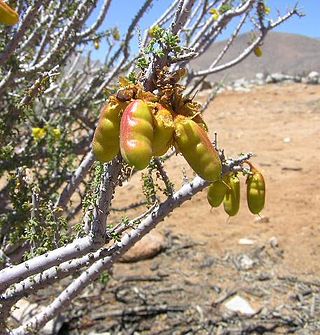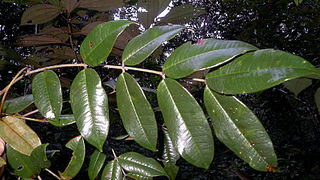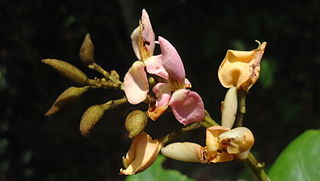
The Mimosoideae are a traditional subfamily of trees, herbs, lianas, and shrubs in the pea family (Fabaceae) that mostly grow in tropical and subtropical climates. They are typically characterized by having radially symmetric flowers, with petals that are twice divided (valvate) in bud and with numerous showy, prominent stamens.

The Faboideae are a subfamily of the flowering plant family Fabaceae or Leguminosae. An acceptable alternative name for the subfamily is Papilionoideae, or Papilionaceae when this group of plants is treated as a family.

Calliandra is a genus of flowering plants in the pea family, Fabaceae, in the mimosoid clade of the subfamily Caesalpinioideae. It contains about 140 species that are native to tropical and subtropical regions of the Americas.

The subfamily Detarioideae is one of the subdivisions of the plant family Fabaceae (legumes). This subfamily includes many tropical trees, some of which are used for timber or have ecological importance. The subfamily consists of 84 genera, most of which are native to Africa and Asia. Pride of Burma and tamarind are two of the most notable species in Detarioideae. It has the following clade-based definition:
The most inclusive crown clade containing Goniorrhachis marginataTaub. and Aphanocalyx cynometroidesOliv., but not Cercis canadensisL., Duparquetia orchidaceaBaill., or Bobgunnia fistuloides(Harms) J. H. Kirkbr. & Wiersema.
Stuhlmannia moavi is a species of flowering plants in the legume family, Fabaceae. It is the only species in the genus Stuhlmannia. It is a tree native to Kenya, Tanzania, and Madagascar, where it grows in seasonally-dry tropical forest, woodland on limestone, and in riverine forest. The genus belongs to tribe Caesalpinieae in subfamily Caesalpinioideae.

Haematoxylum is a genus of flowering plants in the legume family, Fabaceae, subfamily Caesalpinioideae and the tribe Caesalpinieae. It includes five species, four of which are native to the tropical Americas from Mexico to Colombia, and one to Namibia.

Balsamocarpon brevifolium, or algarrobilla, is a species of flowering plants in the legume family, Fabaceae. It is the sole species in genus Balsamocarpon. Balsamocarpon belongs to the subfamily Caesalpinioideae and tribe Caesalpinieae. It is endemic to northern and north-central Chile.
Lophocarpinia aculeatifolia is a species of flowering plants in the legume family, Fabaceae. It is the sole species in genus Lophocarpinia. It is a tree native to Paraguay and northern Argentina. It belongs to tribe Caesalpinieae of subfamily Caesalpinioideae.

Moldenhawera is a genus of flowering plants in the legume family, Fabaceae. It includes 12 species of trees and shrubs endemic to eastern Brazil. They grow in diverse habitats, including restinga, coastal dunes, wooded grassland (cerrado), low mountain scrub on sandstone-derived soils, and rocky montane grassland. It belongs to the subfamily Caesalpinioideae.
Pomaria is a genus of flowering plants in the legume family, Fabaceae. It includes 16 species of shrubs and perennial herbs native to North America, South America, and southern Africa. Typical habitats include drier subtropical grasslands and wooded grasslands, often on limestone, and degraded areas. It belongs to tribe Caesalpinieae of subfamily Caesalpinioideae.

The genus, Pterolobium, consists of 10 species of perennial flowering plants in the family Fabaceae, subfamily Caesalpinioideae and tribe Caesalpinieae. They are sometimes called redwings and are native to the tropical to subtropical climes of Africa and Asia, including Indonesia and the Philippines. They are large scrambling or climbing shrubs that grow in riverside thickets, on rocky slopes or at forest margins. They bear colourful samara fruit, and have pairs of thorns below the rachis of their bipinnate leaves.
Stenodrepanum bergii is a species of flowering plants in the legume family, Fabaceae. It is a perennial subshrub native to northern Argentina. It is the sole member of genus Stenodrepanum. It belongs to tribe Caesalpinieae in subfamily Caesalpinioideae.

Zuccagnia punctata is a species of flowering plant in the family Fabaceae. It is the sole species in genus Zuccagnia. It belongs to tribe Caesalpinieae of subfamily Caesalpinioideae.
Pityrocarpa is a genus of flowering plants in the family Fabaceae. It includes seven species of shrubs and small trees native to the tropical Americas, including western and southeastern Mexico, Guatemala and El Salvador, Venezuela and Guyana, Bolivia, and eastern Brazil. Native habitats include tropical coastal rain forest, gallery forest, secondary forest, woodland, wooded grassland (Cerrado), and thorn scrub (Caatinga). It belongs to the mimosoid clade of the subfamily Caesalpinioideae.

The tribe Dalbergieae is an early-branching clade within the flowering plant subfamily Faboideae. Within that subfamily, it belongs to an unranked clade called the dalbergioids. It was recently revised to include many genera formerly placed in tribes Adesmieae and Aeschynomeneae and to be included in a monophyletic group informally known as the dalbergioids sensu lato. The members of this tribe have a distinctive root nodule morphology, often referred to as an "aeschynomenoid" or "dalbergioid" nodule.

The tribe Exostyleae is an early-branching monophyletic clade of the flowering plant subfamily Faboideae that are mostly found in Neotropical rainforests.

Tara is a genus of flowering plants in the legume family, Fabaceae. It includes three species of trees and shrubs native to the tropical Americas, from northern Mexico through Central America, the Caribbean, and western South America to Bolivia and Central Chile. Typical habitats include seasonally-dry tropical forest and semi-arid thorn scrub. It belongs to tribe Caesalpinieae of subfamily Caesalpinioideae.
Biancaea is a genus of flowering plants in the family Fabaceae. It includes seven species, which range from Yemen to south Asia, Indochina, Malesia, China, Korea, and Japan. It belongs to the subfamily Caesalpinioideae and the tribe Caesalpinieae.
Denisophytum is a genus of flowering plants in the family Fabaceae. It belongs to subfamily Caesalpinioideae and tribe Caesalpinieae. It includes eight species, which have a disjunct distribution – northern Mexico, Florida and the Caribbean, southern South America, the Horn of Africa, the Arabian Peninsula, and Madagascar.
Hererolandia pearsonii is a species of flowering plants in the family Fabaceae. It is the sole species in genus Hererolandia. It is a shrub endemic to Namibia where it grows in Karroo-Namib shrubland. It belongs to tribe Caesalpinieae of subfamily Caesalpinioideae.












